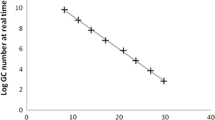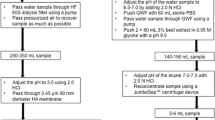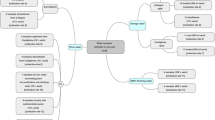Abstract
Enteric viruses are pathogens associated with food- and waterborne outbreaks. The recovery of viruses from food or water samples is affected by the procedures applied to detect and concentrate them. The incorporation of an internal process control virus to the analyses allows monitoring the performance of the methodology. The aim of this study was to produce a recombinant adenovirus (rAdV) and apply it together with bacteriophage PP7 as process controls. The rAdV carries a DNA construction in its genome to differentiate it from wild-type adenovirus by qPCR. The stability of both control viruses was evaluated at different pH conditions. The rAdV was stable at pH 3, 7, and 10 for 18 h. PP7 infectious particles were stable at pH 7 and showed a 2.14 log reduction at pH 10 and total decay at pH 3 after 18 h. Three virus concentration methods were evaluated: hollow-fiber tap water ultrafiltration, wastewater ultracentrifugation, and elution-PEG precipitation from lettuce. Total and infectious viruses were quantified and their recoveries were calculated. Virus recovery for rAdV and PP7 by ultrafiltration showed a wide range (2.10–84.42 and 13.54–84.62%, respectively), whereas that by ultracentrifugation was 5.05–13.71 and 6.98–13.27%, respectively. The performance of ultracentrifugation to concentrate norovirus and enteroviruses present in sewage was not significantly different to the recovery of control viruses. For detection of viruses from lettuce, genomic copies of PP7 were significantly more highly recovered than adenovirus (14.74–18.82 and 0.00–3.44%, respectively). The recovery of infectious virus particles was significantly affected during sewage ultracentrifugation and concentration from lettuce. The simultaneous use of virus controls with dissimilar characteristics and behaviors might resemble different enteric viruses.



Similar content being viewed by others
References
Bae J, Schwab KJ (2008) Evaluation of murine norovirus, feline calicivirus, poliovirus, and MS2 as surrogates for human norovirus in a model of viral persistence in surface water and groundwater. Appl Environ Microbiol 74:477–484. doi:10.1128/AEM.02095-06
Barardi RM, Garcia LAT, Nascimento MA, Barardi CRM (2014) Effect of UV light on the inactivation of recombinant human adenovirus and murine norovirus seeded in seawater in shellfish depuration tanks. Food Env Virol. doi:10.1007/s12560-014-9177-x
Beer KD, Gargano JW, Roberts VA, Hill VR, Garrison LE, Kutty PK, Hilborn ED, Wade TJ, Fullerton KE, Yoder JS (2015) Outbreaks associated with environmental and undetermined water exposures—United States, 2011–2012. Morb Mortal Wkly Rep 64:842–848. doi:10.1136/injuryprev-2011-040066
Bosch A, Guix S, Sano D, Pintó RM (2008) New tools for the study and direct surveillance of viral pathogens in water. Curr Opin Biotechnol 19:295–301. doi:10.1016/j.copbio.2008.04.006
Brandão MLL, Almeida DO, Bispo FCP, Bricio SML, Marin VA, Miagostovich MP (2014) Assessment of microbiological contamination of fresh, minimally processed, and ready-to-eat lettuces (Lactuca sativa), Rio de Janeiro State, Brazil. J Food Sci 79:M961–M966. doi:10.1111/1750-3841.12459
Charles KJ, Shore J, Sellwood J, Laverick M, Hart a, Pedley S (2009) Assessment of the stability of human viruses and coliphage in groundwater by PCR and infectivity methods. J Appl Microbiol 106:1827–1837. doi:10.1111/j.1365-2672.2009.04150.x
Clokie M, Kropinski AM (2001) Bacteriophages: methods and protocols.
Costafreda MI, Bosch A, Pintó RM (2006) Development, evaluation, and standardization of a real-time TaqMan reverse transcription-PCR assay for quantification of hepatitis A virus in clinical and shellfish samples. Appl Environ Microbiol 72:3846–3855. doi:10.1128/AEM.02660-05
Coudray C, Merle G, Martin-latil S, Guillier L, Perelle S (2013) Comparison of two extraction methods for the detection of hepatitis A virus in lettuces using the murine norovirus as a process control. J Virol Methods 193:96–102. doi:10.1016/j.jviromet.2013.05.003
Cromeans TL, Lu X, Erdman DD, Humphrey CD, Hill VR (2008) Development of plaque assays for adenoviruses 40 and 41. J Virol Methods 151:140–145. doi:10.1016/j.jviromet.2008.03.007
Eurosurveillance Editorial Team (2014) Hepatitis A outbreak: report on results from food trace-back investigation. Euro Surveill 36:20896
FAO/WHO (2008) Microbiological hazards in fresh fruits and vegetables: meeting report.
Feng YY, Ong SL, Hu JY, Tan XL, Ng WJ (2003) Effects of pH and temperature on the survival of coliphages MS2 and Qbeta. J Ind Microbiol Biotechnol 30:549–552. doi:10.1007/s10295-003-0080-y
Hata A, Katayama H, Kitajima M, Visvanathan C, Nol C, Furumai H (2011) Validation of internal controls for extraction and amplification of nucleic acids from enteric viruses in water samples. Appl Environ Microbiol 77:4336–4343. doi:10.1128/AEM.00077-11
Hata A, Katayama H, Kojima K, Sano S, Kasuga I, Kitajima M, Furumai H (2014) Effects of rainfall events on the occurrence and detection efficiency of viruses in river water impacted by combined sewer overflows. Sci Total Environ 468–469:757–763. doi:10.1016/j.scitotenv.2013.08.093
He TC, Zhou S, Costa LD, da Costa LT, Yu J, Kinzler KW, Vogelstein B (1998) A simplified system for generating recombinant adenoviruses. Proc Natl Acad Sci 95:2509–2514. doi:10.1073/pnas.95.5.2509
Hill VR, Kahler AM, Jothikumar N, Johnson TB, Hahn D, Cromeans TL (2007) Multistate evaluation of an ultrafiltration-based procedure for simultaneous recovery of enteric microbes in 100-liter tap water samples. Appl Environ Microbiol 73:4218–4225. doi:10.1128/AEM.02713-06
Jończyk E, Kłak M, Międzybrodzki R, Górski A (2011) The influence of external factors on bacteriophages—review. Folia Microbiol (Praha) 56:191–200. doi:10.1007/s12223-011-0039-8
Jothikumar N, Cromeans TL, Hill VR, Lu X, Sobsey MD, Erdman DD (2005a) Quantitative real-time PCR assays for detection of human adenoviruses and identification of serotypes 40 and 41. Appl Environ Microbiol 71:3131–3136. doi:10.1128/AEM.71.6.3131
Jothikumar N, Cromeans TL, Sobsey MD, Robertson BH (2005b) Development and evaluation of a broadly reactive TaqMan assay for rapid detection of hepatitis A virus. Appl Environ Microbiol 71:3359–3363. doi:10.1128/AEM.71.6.3359
Jothikumar N, Lowther JA, Henshilwood K, Lees DN, Hill VR, Vinje J (2005c) Rapid and sensitive detection of noroviruses by using TaqMan-based one-step reverse transcription-PCR assays and application to naturally contaminated shellfish samples. Appl Environ Microbiol 71:1870–1875. doi:10.1128/AEM.71.4.1870
Jothikumar N, Cromeans TL, Robertson BH, Meng XJ, Hill VR (2006) A broadly reactive one-step real-time RT-PCR assay for rapid and sensitive detection of hepatitis E virus. J Virol Methods 131:65–71. doi:10.1016/j.jviromet.2005.07.004
Julian TR, Schwab KJ (2012) Challenges in environmental detection of human viral pathogens. Curr Opin Virol 2:78–83. doi:10.1016/j.coviro.2011.10.027
Kilpatrick DR, Yang CF, Ching K, Vincent A, Iber J, Campagnoli R, Mandelbaum M, De L, Yang SJ, Nix A, Kew OM (2009) Rapid group-, serotype-, and vaccine strain-specific identification of poliovirus isolates by real-time reverse transcription-PCR using degenerate primers and probes containing deoxyinosine residues. J Clin Microbiol 47:1939–1941. doi:10.1128/JCM.00702-09
Lees D (2010) International standardisation of a method for detection of human pathogenic viruses in molluscan shellfish. Food Environ Virol 2:146–155. doi:10.1007/s12560-010-9042-5
Liu P, Hill VR, Hahn D, Johnson TB, Pan Y, Jothikumar N, Moe CL (2012) Hollow-fiber ultrafiltration for simultaneous recovery of viruses, bacteria and parasites from reclaimed water. J Microbiol Methods 88:155–161. doi:10.1016/j.mimet.2011.11.007
Loisy F, Atmar RL, Guillon P, Le Cann P, Pommepuy M, Le Guyader FS (2005) Real-time RT-PCR for norovirus screening in shellfish. J Virol Methods 123:1–7. doi:10.1016/j.jviromet.2004.08.023
Martin-Latil S, Hennechart-Collette C, Guillier L, Perelle S (2014) Method for HEV detection in raw pig liver products and its implementation for naturally contaminated food. Int J Food Microbiol 176:1–8. doi:10.1016/j.ijfoodmicro.2014.01.016
Matsushita T, Shirasaki N, Tatsuki Y, Matsui Y (2013) Investigating norovirus removal by microfiltration, ultrafiltration, and precoagulation-microfiltration processes using recombinant norovirus virus-like particles and real-time immuno-PCR. Water Res 47:5819–5827. doi:10.1016/j.watres.2013.07.004
Monpoeho S, Maul A, Schwartzbrod L, Billaudel S, Virologie LD, Dieu CHUH, Processing D (2001) Best viral elution method available for quantification of enteroviruses in sludge by both cell culture and reverse transcription-PCR. Appl Environ Microbiol 67:2484–2488. doi:10.1128/AEM.67.6.2484
Pal A, Sirota L, Maudru T, Peden K, Lewis AM (2006) Real-time, quantitative PCR assays for the detection of virus-specific DNA in samples with mixed populations of polyomaviruses. J Virol Methods 135:32–42. doi:10.1016/j.jviromet.2006.01.018
Petterson S, Grøndahl-Rosado R, Nilsen V, Myrmel M, Robertson LJ (2015) Variability in the recovery of a virus concentration procedure in water: implications for QMRA. Water Res 87:79–86. doi:10.1016/j.watres.2015.09.006
Poma HR, Rajal VB, Blanco Fernández MD, Barril PA, Giordano MO, Masachessi G, Martínez LC, Isa MB, Freire MC, López Riviello G, Cisterna D, Nates SV, Mbayed VA (2013) Evaluation of concentration efficiency of the Pseudomonas aeruginosa phage PP7 in various water matrixes by different methods. Environ Monit Assess 185:2565–2576. doi:10.1007/s10661-012-2731-9
Puig M, Allard A, Lucena F, Wadell G, Jofre J, Girones R (1995) Detection of adenovirus and enterovirus by PCR amplification in polluted waters. Water Sci Technol 31:351–357. doi:10.1016/0273-1223(95)00291-T
Rajal VB, McSwain BS, Thompson DE, Leutenegger CM, Kildare BJ, Wuertz S (2007) Validation of hollow fiber ultrafiltration and real-time PCR using bacteriophage PP7 as surrogate for the quantification of viruses from water samples. Water Res 41:1411–1422. doi:10.1016/j.watres.2006.12.034
Rexroad J, Evans RK, Middaugh CR (2006) Effect of pH and ionic strength on the physical stability of adenovirus type 5. J Pharm Sci 95:237–247. doi:10.1002/jps.20496
Rhodes ER, Huff EM, Hamilton DW, Jones JL (2016) The evaluation of hollow-fiber ultrafiltration and celite concentration of enteroviruses, adenoviruses and bacteriophage from different water matrices. J Virol Methods 228:31–38. doi:10.1016/j.jviromet.2015.11.003
Summa M, von Bonsdorff C-H, Maunula L (2012) Evaluation of four virus recovery methods for detecting noroviruses on fresh lettuce, sliced ham, and frozen raspberries. J Virol Methods 183:154–160. doi:10.1016/j.jviromet.2012.04.006
Verhoef L, Hewitt J, Barclay L, Ahmed SM, Lake R, Hall AJ, Lopman B, Kroneman A, Vennema H, Vinjé J, Koopmans M (2015) Norovirus genotype profiles associated with foodborne transmission, 1999–2012. Emerg Infect Dis 21:592–599. doi:10.3201/eid2104.141073
Victoria M, Guimarães F, Fumian T, Ferreira F, Vieira C, Leite JP, Miagostovich M (2009) Evaluation of an adsorption-elution method for detection of astrovirus and norovirus in environmental waters. J Virol Methods 156:73–76. doi:10.1016/j.jviromet.2008.11.003
Wu J, Simmons OD, Sobsey MD (2013) Uncertainty analysis of the recovery of hollow-fiber ultrafiltration for multiple microbe classes from water: a Bayesian approach. J Microbiol Methods 93:161–167. doi:10.1016/j.mimet.2013.03.005
Zeng SQ, Halkosalo A, Salminen M, Szakal ED, Puustinen L, Vesikari T (2008) One-step quantitative RT-PCR for the detection of rotavirus in acute gastroenteritis. J Virol Methods 153:238–240. doi:10.1016/j.jviromet.2008.08.004
Acknowledgments
This work was supported by grants from Universidad de Buenos Aires (SECyT-UBA 20020100100405) and Agencia Nacional de Promoción Científica y Tecnológica (ANPCyT; PICT 2012-2679), Argentina. Funding sources had no involvement in the study design, collection, analysis and interpretation of data, writing of the paper, or the decision to submit the article for publication. We thank Drs. Juan Stupka, Karina Gomes, Daniel Cisterna, and Leila Martínez from the Virology Department of the Instituto Nacional de Enfermedades Infecciosas - ANLIS Dr. Carlos G. Malbrán for their help with norovirus and enterovirus quantitation. We thank María Victoria Gonzalez Eusevi for correction of the English language.
Author information
Authors and Affiliations
Corresponding author
Ethics declarations
This article does not contain any studies with human participants or animals performed by any of the authors.
Conflict of interest
The authors declare that they have no conflict of interest.
Electronic supplementary material
ESM 1
(PDF 133 kb)
Rights and permissions
About this article
Cite this article
Blanco Fernández, M.D., Barrios, M.E., Cammarata, R.V. et al. Comparison of internal process control viruses for detection of food and waterborne viruses. Appl Microbiol Biotechnol 101, 4289–4298 (2017). https://doi.org/10.1007/s00253-017-8244-2
Received:
Revised:
Accepted:
Published:
Issue Date:
DOI: https://doi.org/10.1007/s00253-017-8244-2




